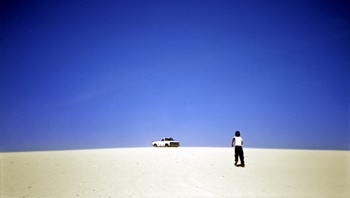Centro Cultural Tijuana- CECUT,
Oct 01, 2008 - Feb 01, 2009
Tijuana, Baja California, Mexico
Proyecto Cívico / Civic Project
by Marcela Quiroz Luna
For its part, Torolab's piece registers the movement of 5 individuals with different migrant status. They are tracked traveling between Ensenada, Baja California, and Los Angeles in order to collect information on their routes, speed, fuel expenses and commercial transactions. In contrast to Francis Alí¿s's piece, Cárdenas's work looks at the relationship of specific individuals to their context, while emphasizing the former's conditions of "consumption" on the latter. Similar to the 500 people invited by Alí¿s to move the Peruvian dune, Cárdenas' subjects are also "anonymous" to a certain extent, and the relevance of registering their actions is not evident. However, the singularity of their position as displacement and operating condition is reason enough to locate them on a surveyor's map and place them in a box with white edges. The box serves as a projection screen for their movements over a five-day period registered by GPS locators carried in their so-called "cross-border pants" designed as part of the 'Torovestimenta' line of clothing. The purpose of the project was to extract from substantial and specific data to address, like an expanding network, the links and commercial necessities of two countries that are dependent of, and are accomplices to, the same ambulatory indistinctions. If, in the final analysis, the five little luminous bulbs that move across Torolab's map seem to point to the same "intranscendental" content of the 500 shovels on Alí¿s's dune, it seems that the curators have attempted to integrate the question over the redeeming yet neutralizing capacities of individual agency in the public sphere.
As part of this atmosphere of the unexplainable as a narrative vacuum, the works by Sergio de la Torre (Tijuana, Mexico, 1967) and Javier Ramírez Limón (Sonora, Mexico, 1960) are exceptional. Both are a blend of video and photographic images dealing with fragmentation.
In Desierto del Altar (2000) -a series of 3 large-scale images that greet visitors upon entering the Proyecto Cívico galleries- Ramírez Limón partly captures an everyday illegal trafficking scene in the Sonoran desert. The images just focus on three thinly populated landscapes in a slender strip of desert. The exchange, if it takes place at all, cannot be seen by the viewer due to the length of the shot and the hazy, unreal quality of the desert. The viewer is an accessory to an incomplete narrative in which illegality, as a form of exclusion, remains intact.
Sergio de la Torre's New Dragon City (2008) is a film of 6 Cantonese youths converting the ground floor of a building on a busy street in downtown Tijuana into a sort of bunker. After blocking all the entrances and windows, they hunker down in the heat. The reasons for their lying in hiding remain in the air, in a loop lasting 15 minutes. Lost in the darkness of the room, the viewer, lacking any sense of certainty, ends up filling the vacuum with mistrust. To one side, two pieces by Daniel Ruanova (Mexicali, Mexico, 1976), Becoming BOWSER and DEFENSE/ La oposición complementaria (DEFENSE/Complementary opposition, 2008) carry the notion of entropic survival as a last resort. A notion extended over the appearance and recycled materials of his objects.
A video by Mircea Cantor (Oradea, Romania, 1977), The Landscape is Changing (2003), films a citizens' action. The group carrying blank reflective banners act as slogans removed of ideological content, to the sounds of Prokofiev's March of the Montague and Capulets. It is communal displacement as a visual and aesthetic game whose significance lies in its becoming situationist, which would seem to confirm its perennial relevance. In the midst of those solemn sounds, Gabriel Acevedo (Lima, Peru, 1976) greets and hugs strangers in his video, For all the people I won't meet (2006).
Visitors, made fully aware of the use of sound in the exhibition as a intentionally or inevitably polyvalent corporal dimension, listen to the voice of Fabián Cerejido (Buenos Aires, Argentina, 1961), as his face disappears into the milky surface of a ceramic plate in the video installation A Tijuana en Leche (To Tijuana in Milk, 2005). Further along, Beethoven's music is blended with The Doors's lyrics in the alienating civilizing project, Wild Boy (2004) by Guy Ben-Ner (Ramat Gan, Israel, 1967).
Proyecto cívico's nearby and distant murmurs serve to fine tune the meaning(less) feeling of our own clandestine (in) mobility, suggesting the thrust of an energy that cannot be used but can be found in more than one system. A place for art can be found in the still detectable potential of entropy, in the nooks and crannies of its structures and the crumbs of its civility.
- Marcela Quiroz
|









